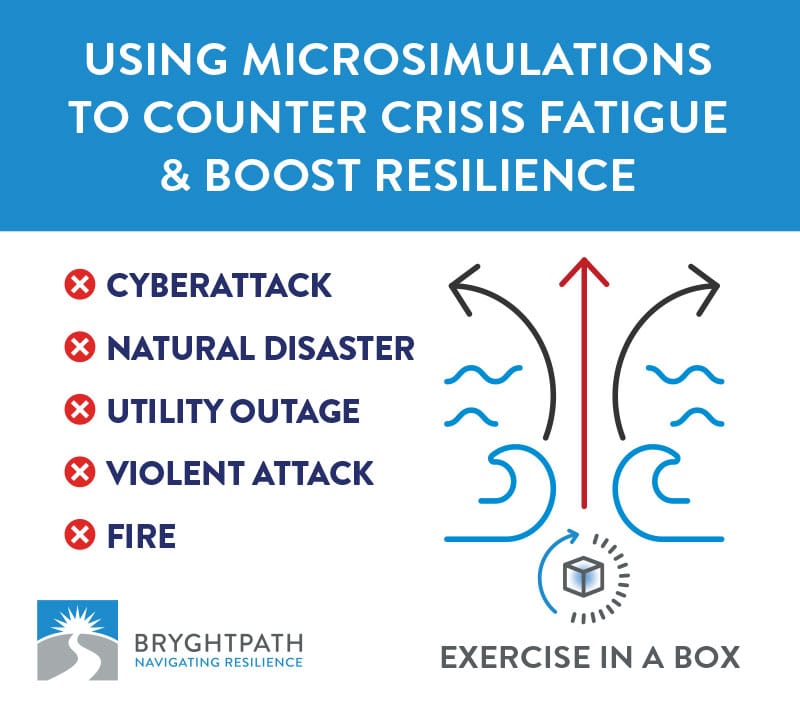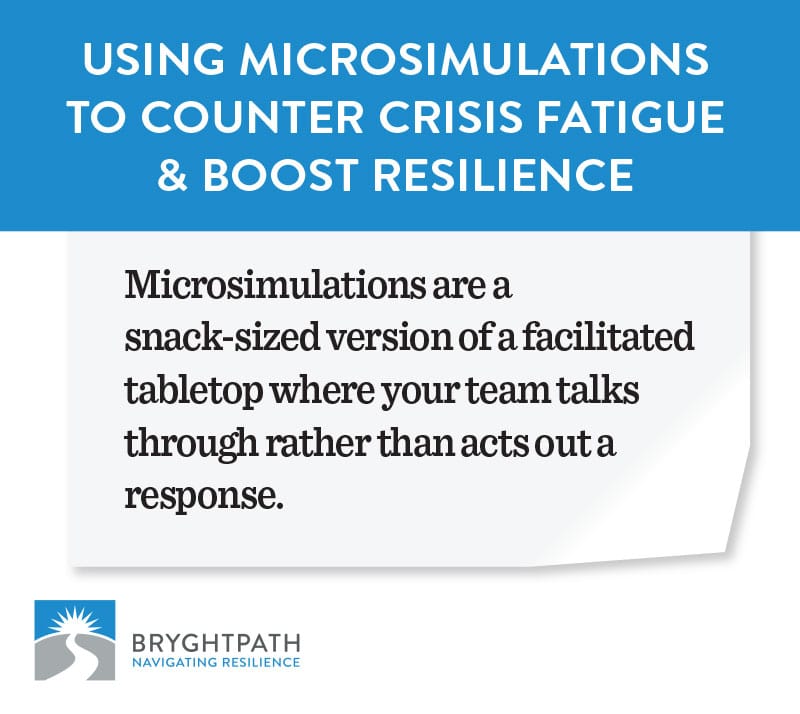Pandemics, droughts, floods, school shootings, political turmoil, war.
Is it just me, or does it seem like a lot of us are stuck in a riptide of never-ending crises? Flailing arms, saltwater up our noses, a mild sense of panic at what lurks below, and exhaustion setting in.
Yet now is not the time to stop swimming. Threats are evolving at a breakneck pace, and the gaps in our resilience planning are starting to show. Organizations need to quickly get their people re-engaged in resilience thinking and learn to use crisis microsimulations.
But who has the time or energy left to exercise for the next crisis when we still haven’t recovered from the real ones we’ve faced over these past many months?
Sometimes, the best solution is also the most counterintuitive. Like swimming sideways or perpendicular to a riptide to reach the shore.
Could microsimulations be the sideways-swimming solution to our crisis fatigue woes?
- Exercised in a small group
- In less than an hour
- Without the help of an expert facilitator
- And as simple or customizable as your budget and imagination can afford?
If your organization is looking for out-of-the-box solutions to meet your business continuity and crisis management challenges, microsimulations, or what we like to call an Exercise in a Box, might be the answer.
Here, we talk more about what microsimulations are, their advantages, and how to use them effectively as part of your business continuity and crisis exercise program.

What is a Microsimulation in Crisis and Business Continuity Planning?
Every business needs an exercise strategy or action plan to test and practice its business continuity and crisis plans. But not all exercises are alike or appropriate, depending on your business and what stage it’s at in developing its exercise strategy.
Using a full simulation on a team that’s never experienced an exercise can lead to overwhelm and confusion. Conversely, conducting an exercise that’s not challenging enough does little to build your organization’s resilience muscles. That’s why we use a combination of exercise types—full simulations, lightweight simulations, facilitated tabletops (where your team talks through rather than acts out a response), and drills—when designing an exercise strategy for each of our clients.
Within this range of exercise building blocks, we like to think of microsimulations as a snack-sized version of a facilitated tabletop. In a microsimulation, you and your team talk through, then debrief and hotwash a distinct set of exercise “moves” in response to a specific scenario, such as an active shooter, building collapse, natural disaster, or cybersecurity breach. But while other types of exercises can take anywhere from several hours to multiple days to conduct, a microsimulation is specifically designed to be completed easily in less than an hour.

3 Ways Crisis Microsimulations Can Help Build Resilience
We don’t recommend relying on microsimulations as the standalone solution to your exercise needs. But when layered into a larger exercise strategy along with other types of complementary exercises, they can be incredibly useful.
Here are some of the key advantages of using microsimulations.
1. Bite-sized lessons help you ditch the overwhelm
It’s one thing to document a chain of triggers and actions as part of a business continuity or crisis management plan, but quite another to exercise those plans. Especially when they involve a lot of people, a lot of steps, and multiple locations.
That’s still no excuse for not exercising your plans. But how DO you get your business team prepared tactically to do the hard things and make the split decisions they need to when a crisis hits?
Microsimulations or drills can help you break big plans into smaller bite-sized pieces that can be tackled more easily. Microsimulations can be specifically designed to help your team members talk through the steps and gain familiarity with the tools they need to respond to a disruption.
When done regularly over time, the lessons learned in microsimulations can be stacked up to improve your team’s confidence and build their response capabilities. And if your organization or team members are new to exercising your crisis and business continuity plans, microsimulations can be a helpful stepping stone to prepare them for more complex exercises.
2. Easy to schedule when time resources are limited
Full simulations take several days, sometimes even a week to execute. Even a light simulation or tabletop exercise can take hours to prepare, conduct, and debrief. In talking with the business continuity professionals that we advise, we know that it’s often difficult to pull staff away from their day-to-day roles to prepare for the next “what if” scenario.
Microsimulations can help you get ahead with a minimal investment in your team’s time. And, without having to involve every possible participant at the same time.
3. Budget-friendly
A full-scale business continuity or crisis management exercise can cost upwards of $50,000 to conduct. If your company doesn’t have those resources at its disposal yet (you can read more about making the business case to your leaders here), then microsimulations might be the next best answer.
Microsimulations are a great way to continue to build awareness of your program and to practice and reinforce resilience practices without a huge investment.
Getting Started with Crisis Microsimulations
There are a few common mistakes that can derail any business continuity or crisis exercise. Like:
- Not taking the time to align your exercise to your objectives
- Making your exercise too hard, too easy, or unrealistic
- Poorly coordinating exercises across organizational silos
- Not having a plan for debriefing and incorporating your learnings into future plans and responses
That’s why if you’re looking to start using microsimulations in your organization, my first piece of advice is to make sure you incorporate them into a larger exercise strategy. A thoughtful exercise strategy helps ensure that exercises are appropriately designed and that you get the most out of your learnings.
Then, my advice is this.
- Keep it simple: Even the simplest exercise can be overwhelming to someone unfamiliar with what a business continuity or crisis response involves and how to execute it. An effective microsimulation should be appropriately challenging- yet achievable – for all team members. Your objective is to give your team a realistic but doable task that will help them build familiarity with the steps in a crisis and continuity response.
- Make it realistic: Tornados, floods, political unrest, a breakdown of key facilities? Your exercises should be calculated to the crisis situations your business is most likely to encounter. They should also reflect on what a real-life situation would look like as much as possible. Our Exercise-in-a-Box scenarios are designed to address the most common crisis scenarios we’ve worked through with real clients, including:
- Active Assailant / Active Shooter
- Building Collapse
- Chemical Spill – Shelter in Place
- Earthquake
- Fire
- Flood
- Hostage Situation
- Hurricane
- Network Outage
- Pandemic Influenza
- Ransomware
- Severe Winter Weather
- Tornado
- Utility Failure
- Wildfire
- Make it approachable: Unlike full simulations and exercises, microsimulations are not the time to labor over spreadsheet tracking and detailed checklists. Yes, simple templates and spreadsheets, like we provide with Exercise in a Box, can help facilitate your microsimulation exercise. But don’t forget to keep the experience approachable and conversational, as well. Microsimulations can provide a highly practical and accessible forum to help stimulate valuable questions and discussion. You’ll be surprised at what you and your team can learn by simply engaging with a curious spirit and an open ear.
Want to empower your business leaders with effective crisis microsimulations?
In our experience, business teams that practice crisis, disruption, and business continuity scenarios respond faster and recover more quickly than teams that do not.
Managing crisis & continuity exercises for hundreds of business units worldwide is a tall order. That’s why we’ve developed a set of crisis & continuity exercises that can be executed by a business leader in an hour or less – and don’t require expert facilitation from a crisis management or business continuity team.
Our Exercise in a Box scenarios and materials were written by the battle-tested experts in crisis management, business continuity, and crisis communications at Bryghtpath.
Need some help to start using microsimulations in your organization or want to learn more?
- Our Exercise in a Box product contains 15 simple tabletop exercise scenarios that your business leaders can utilize for crisis microsimulations with minimal involvement from your team.
- Our proprietary Resiliency Diagnosis process is the perfect way to advance your crisis management, business continuity, and crisis communications program. Our thorough standards-based review culminates in a full report, maturity model scoring, and a clear set of recommendations for improvement.
- Our Crisis Management services help you rapidly implement and mature your program to ensure your organization is prepared for what lies ahead.
- Our Ultimate Guide to Crisis Management contains everything you need to know about Crisis Management
- Our Free Crisis Management 101 Introductory Course may help you with an introduction to the world of crisis management – and help prepare your organization for the next major crisis situation.
- Learn about our Free Resources, including articles, a resource library, white papers, reports, free introductory courses, webinars, and more.
- Set up an initial call with us to chat further about how we might be able to work together


 Before, During, and After Landing my First Job “Out of College”
Before, During, and After Landing my First Job “Out of College”